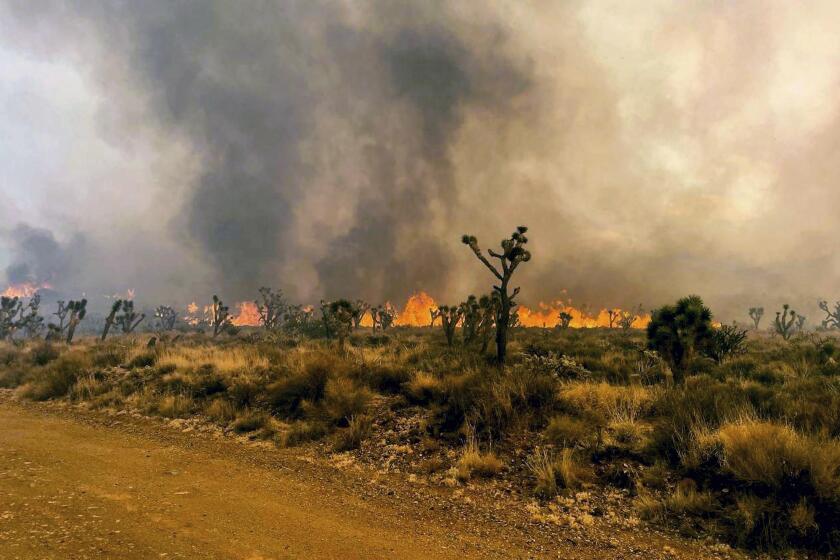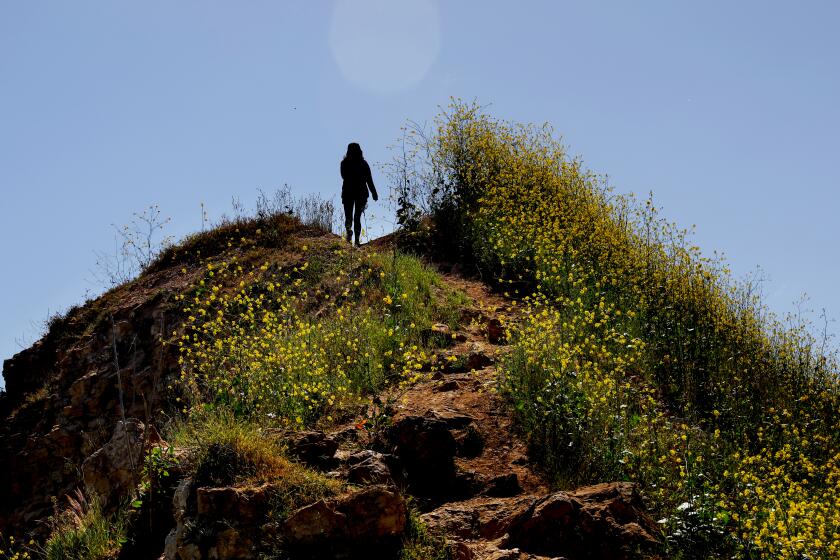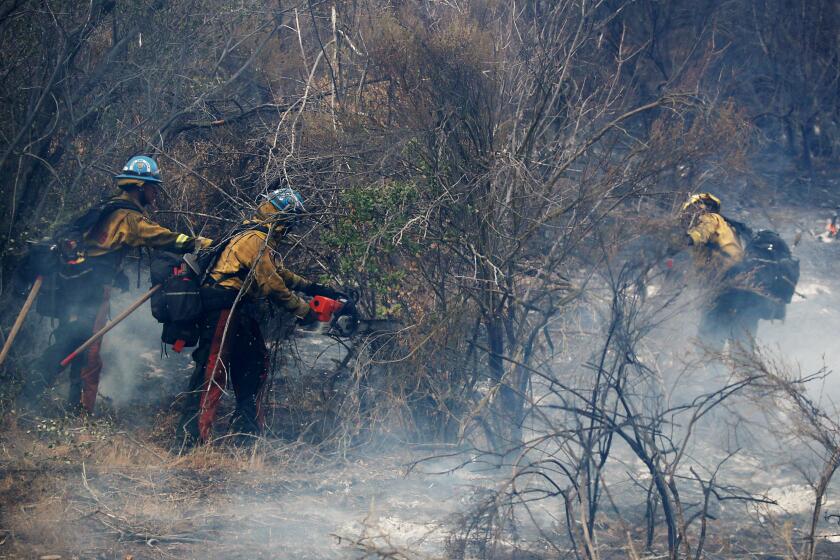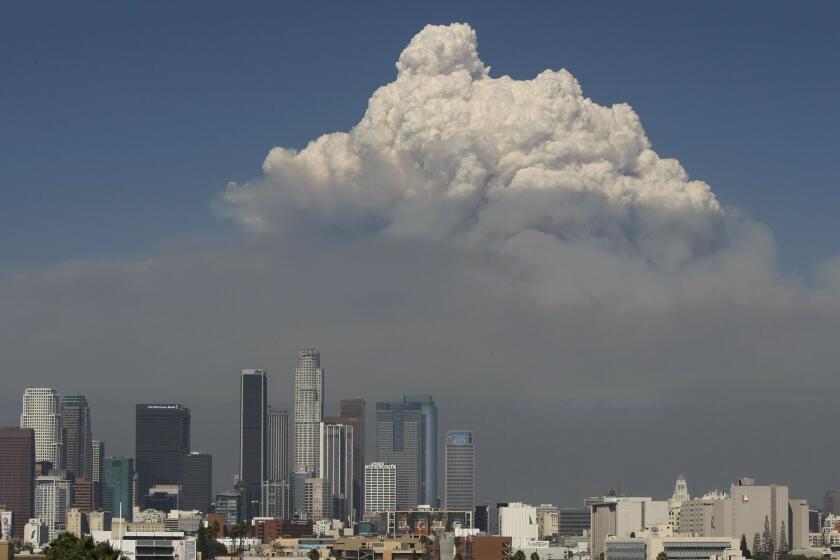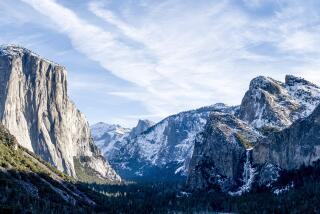The Mojave Desert is burning in California’s biggest fire of year, torching Joshua trees
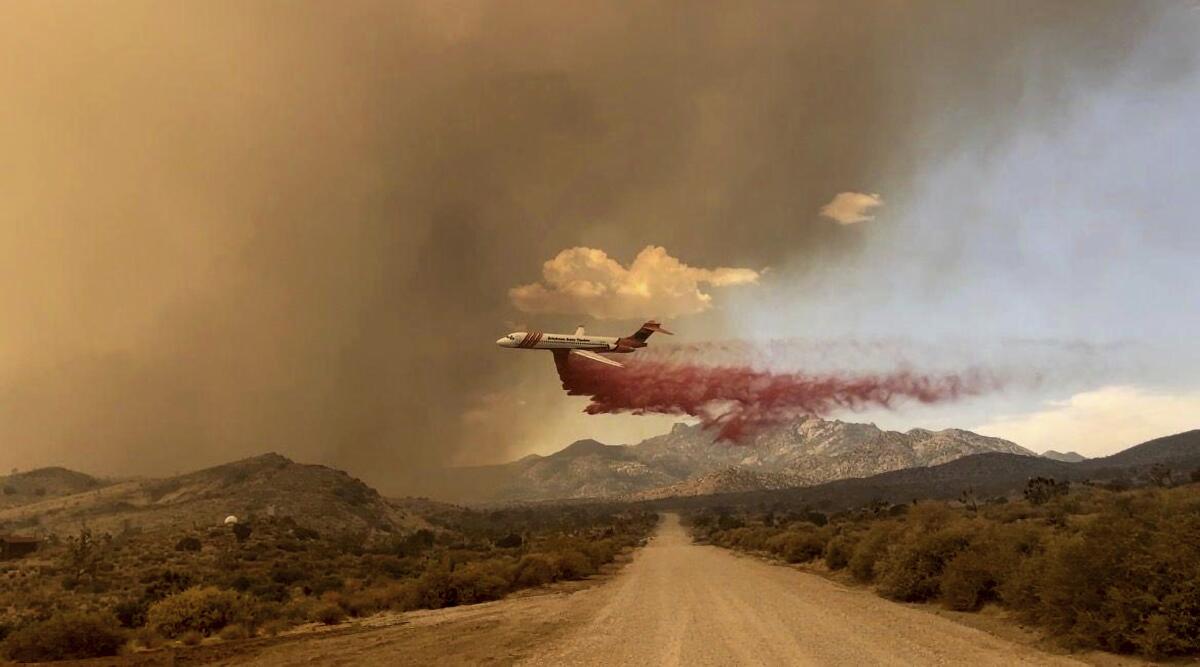
- Share via
California’s biggest wildfire of the year — burning through delicate Joshua tree forests along the California-Nevada border — is an unusual desert blaze being fueled in part by the rapid growth of underbrush from this winter’s record rains.
The York fire had scorched 77,000 acres as of Monday, with no containment. After first being observed Friday, the blaze has spread mainly across the Mojave National Preserve in eastern San Bernardino County, but recently jumped into southwestern Nevada. No evacuations have been issued as a result of the fire, which is burning in mostly remote areas.
“It’s a public misconception that the desert doesn’t burn, but we’re seeing right here that that’s not case,” said Sierra Willoughby, a supervisory park ranger at Mojave National Preserve. “They’re not as rare as we would hope them to be.”
Just 10 days before this wildfire was spotted in the New York Mountains area of the Mojave National Preserve, park officials warned of extreme fire risk for the federally protected desert, banning all open flames.
“Even though we had a good moisture year with the [winter] season, the very high temperatures that came in July were a concern for our fire folks,” Willoughby said.
Firefighters struggled to slow the York fire as it rampaged across a Mojave Desert landscape that is a vast, delicate and vital ecosystem.
Southern California’s wet winter and cool spring helped foster increasing levels of invasive grasses and underbrush in the Mojave and Colorado deserts, federal officials said, which has made the region exceptionally susceptible to brush fires this summer as those plants dry out.
This year’s climate patterns have provided a “more continuous fuel bed” than is typical for desert ecosystems, UCLA climatologist Daniel Swain said on Twitter.
“Big fires in the desert are entirely consistent with the fire season outlook for 2023,” Swain wrote, noting that poses a major concern for ecologists and desert conservationists.
Fire regimes tend to vary on a gradient from climate-limited, in which there is an abundance of fuel but conditions are often too wet to carry fire, to fuel-limited, in which the climate is generally conducive to fire but there is usually not enough vegetation to carry it.
For this reason, forecasters had called for a less active fire season in California’s higher-elevation forests, which are dense but remain moist from the wet winter. But at lower elevations, the rains helped more grasses grow, and then several weeks of high temperatures caused the vegetation to dry out — or cure — priming it to become wildfire fuel.
Already, a June 10 wildfire burned more than 1,000 acres in the Pleasant Valley area of Joshua Tree National Park. Invasive grasses played a role in stoking that fire, known as the Geology fire, which burned in an area populated by Joshua trees, Mojave yucca, creosote and senna, park officials said.
“Most of the deserts in the southwestern U.S. are fairly fuel-limited in dry years, so there was that kind of natural fire break between plants or keeping it confined to relatively small areas,” said Christopher McDonald, a natural resources advisor at UC Cooperative Extension.
But after a year of above-average rainfall, there’s more fuel connecting perennial shrubs and Joshua trees, which enables fire to spread among the plants, he said. Hot, windy conditions further primed vegetation to burn.
Firefighters in California have already responded to more than 640 wildland fires this year alone, including 135 in the last week.
Joshua trees and other desert plants have limited natural defenses to fires, officials said, and would struggle to recover from such blazes.
For the record:
3:01 p.m. Aug. 1, 2023A previous version of this story said endangered tortoises that live in the area of the fire could be harmed. The Mojave desert tortoise is listed as threatened under the Endangered Species Act.
The extent of the plants and animals at risk in the York fire are still under investigation, Willoughby said, noting that the blaze has already burned through Joshua tree, juniper and pinyon pine groves. Mojave desert tortoises, listed as threatened under the Endangered Species Act, also could be harmed, said Stephanie Bishop, a National Park Service public information officer and a spokesperson for the York fire.
“What we’ve seen is fires go through these areas and take out quite a bit,” Willoughby said. The York fire is burning in some of the areas that last saw flames in 2005 from the Hackberry Complex fire, which eventually burned more than 70,000 acres. Willoughby said many of the forests harmed in that blaze 18 years ago still have not recovered.
Track wildfire origins, perimeters and air pollution with the L.A. Times California wildfires map.
The 2020 Dome fire, which burned more than 40,000 acres across the southwestern California desert — including in the national preserve, but in a different area from the York fire — destroyed an estimated 1 million Joshua trees. Crews and volunteers are trying to replant and revitalize those groves.
In the Eastern Mojave, the heavy winter rains stoked the growth of native grasses, including big galleta, said ecologist Laura Cunningham, California’s director at the Western Watersheds Project and co-founder of conservation group Basin and Range Watch. The area doesn’t have as many invasive grasses, such as red brome and cheatgrass, which are more common in low-creosote deserts, but it does have a big Sahara mustard problem, which could be adding to the fuel, she said.
Some models suggest that increased global temperatures as a result of climate change are bringing more rain to the Mojave desert, fueling grass growth and the risk of lightning strikes, Cunningham said. On top of that, more humans traveling into desert areas increases the risk of sparks — from a bullet glancing off a rock while someone is target shooting or a chain dragging on the pavement while someone is hauling a trailer, she said.
The New York Mountains in the Mojave National Preserve have an enormous density of rare plants, including blue blossom, manzanita and uncommon chaparral shrubs, that could be devastated by fire, she said.
“In those desert areas, the mountains are like sky islands, they call them,” she said — they rise from the “sea” of the hot desert floor that surrounds them and host dramatically different populations of plants and animals.
She thinks the vegetation and plants will recover from the fire, but probably very slowly — too slowly for one person to witness in their lifetime, she said.
“It’s kind of sad because it won’t be when we can see it,” she said. “We can watch it recover slowly, but those old-growth Joshua tree woodlands and shrublands, we won’t see those again in our lifetimes.”
California’s other big fire of the year — the Bonny fire, which has charred 2,300 acres in Riverside County — is also burning across some arid landscapes as well as through the mountains. It has forced 122 people to evacuate their homes, with almost 800 structures threatened, according to officials with the California Department of Forestry and Fire Protection.
The Bonny fire, burning south of Anza, was 20% contained as of Monday morning. One structure has been destroyed, and at least one firefighter was injured in the effort to control the flames. Almost 2,000 personnel are working that blaze, which began Thursday. Its cause is under investigation.
Gov. Gavin Newsom and California fire officials outline plans for ‘peak’ fire season.
Winds remain a major concern for both fires, officials have said.
A challenging weekend of high winds up to 30 mph sparked dangerous fire whirls that pushed the York fire across the Mojave National Preserve, said Bishop, a spokesperson for the York fire and a National Park Service public information officer. The weather overnight into Monday had improved slightly, with winds that were not as strong and some precipitation, which allowed for some groundwork and minimal fire growth, she said.
A monsoonal influence in the area could produce more of that helpful precipitation, but that pattern typically comes with heavy winds, officials said, and the test of the hot desert heat remains.
Firefighters and meteorologists look to a little-known metric called “mixing height” to understand how explosive wildfires spread in California without wind.
“The biggest challenge today that they’re going to be dealing with is limited visibility due to thick smoke,” Bishop said, noting that visibility has dropped to one mile in some areas.
Federal, state and local firefighting teams are battling the York fire, with more than 260 personnel assigned, officials said. The fire has also moved into the Avi Kwa Ame National Monument, which is Bureau of Land Management land, Willoughby said.
What ignited the fire remains under investigation, but Bishop said it was determined to have started on private land within the preserve.
Cunningham expressed concern for area residents — as people live in Fourth of July Canyon, right next to Caruthers Canyon, where there are inholdings within the preserve. The fire is also spreading toward Nipton and Searchlight, she said.
“Today is going to be a windy monsoonal stormy day, so we’ll see,” she said. “This ain’t over till it’s over.”
Big fires in the Mojave Desert are “unfortunately becoming a greater concern,” McDonald said.
“Historically, in general, deserts tended to burn fairly infrequently,” he said. “And that’s one of the reasons why you have a lot of these long-lived plants that can grow into big giant Joshua trees, or saguaros in the Sonoran Desert. But as more and more invasive plants, especially invasive grasses, have grown in desert areas, they’re able to carry fire and burn those long-lived plants and cause a change in the fire regime.”
An increase in fire can also lead to a shifting of habitats into something new, Cunningham said.
“If there are too many fires that happen in the same place over and over again, that can eliminate Joshua trees and other plants and turn it into some other type of vegetation,” she said. “So that’s definitely a concern. And again, if temperatures get hotter, that can cause vegetation to sort of migrate upward in elevation or more northerly.
“We know climate change is impacting the earth, so we have to really protect these special places now — really try to maintain them in a resilient way,” she added. “If there’s going to be a fire, we have to help them recover. They will restore themselves, but we can maybe speed up the process by preventing other fires in those same locations, maybe actively planting some seeds out there to help the plants regrow.”
More to Read
Sign up for Essential California
The most important California stories and recommendations in your inbox every morning.
You may occasionally receive promotional content from the Los Angeles Times.
